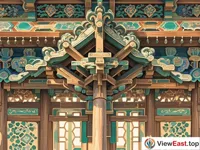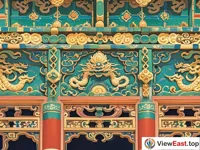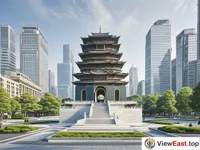








Introduction
Ancient Chinese architectural art is renowned worldwide for its unique aesthetics and exquisite craftsmanship. The Great Wall winds for thousands of miles, and the Forbidden City shines with splendor. These architectural wonders not only bear witness to China's extensive history but also showcase the extraordinary achievements of ancient Chinese architectural art. They are epics set in brick and stone, telling tales that span a millennium.
The Great Wall: The Spine of the Nation
The Great Wall, one of the world's cultural heritage sites, is a testament to the wisdom of the ancient Chinese laborers. It is not only a military defense project but also a symbol of the Chinese nation.
The Undulating Dragon
The construction of the Great Wall spans several dynasties, with a total length of over 20,000 kilometers, resembling a dragon meandering through the mountains and hills. Every brick and stone of the Great Wall carries the weight of history, and each beacon tower narrates the smoke of ancient wars.
Wisdom in Construction
The construction of the Great Wall took full advantage of the terrain, using the mountainous landscape for defense, demonstrating the ancients' profound understanding and utilization of natural conditions. Its solid walls and intricate structures reflect the superb architectural techniques of the time.
The Forbidden City: The Symbol of Imperial Power
The Forbidden City, also known as the Purple Forbidden City, was the royal palace for the Ming and Qing dynasties and is an outstanding representative of ancient Chinese architectural art.
The Resplendent Palaces
The Forbidden City's architectural complex is vast and meticulously laid out. The resplendent palaces and exquisite carvings reflect the nobility and power of the imperial court. Every detail has been carefully designed, showcasing the superb skills of ancient craftsmen.
The Vessel of Court Culture
The Forbidden City is not only a treasure trove of architectural art but also a vessel of court culture. It has witnessed countless historical events and houses a vast collection of precious artifacts, making it an essential site for studying ancient Chinese history and culture.
Ancient Chinese Architectural Art: Harmony and Wisdom
Ancient Chinese architectural art is known for its distinctive style and profound cultural connotations. From grand palaces and solemn temples to exquisite gardens, they all embody the ancient pursuit of harmony and beauty.
The Ingenuity of Wooden Structures
Ancient Chinese buildings often utilized wooden structures, which not only had good seismic resistance but were also easy to construct and maintain. The design of components such as brackets and beams was both practical and aesthetically pleasing, demonstrating the wisdom of ancient craftsmen.
The Mood of Gardens
Chinese gardens are famous for their unique landscape techniques and profound artistic conception. The rocks, water, plants, and architecture within the gardens complement each other, creating a tranquil and distant atmosphere, reflecting the ancient pursuit of harmony with nature.
Conclusion
The Great Wall, the Forbidden City, and other examples of ancient Chinese architectural art are a source of pride for the Chinese nation and a precious asset to human civilization. Delving deeper into these architectural wonders allows us to better understand Chinese culture and ignites our passion for architectural art and respect for history.
Exploring ancient Chinese architectural art, we can learn how to combine traditional aesthetics with modern design; studying ancient buildings, we can learn how to seek and create harmony and beauty in modern society. The essence of these architectural marvels is not only a display of technique but also the transmission of culture.